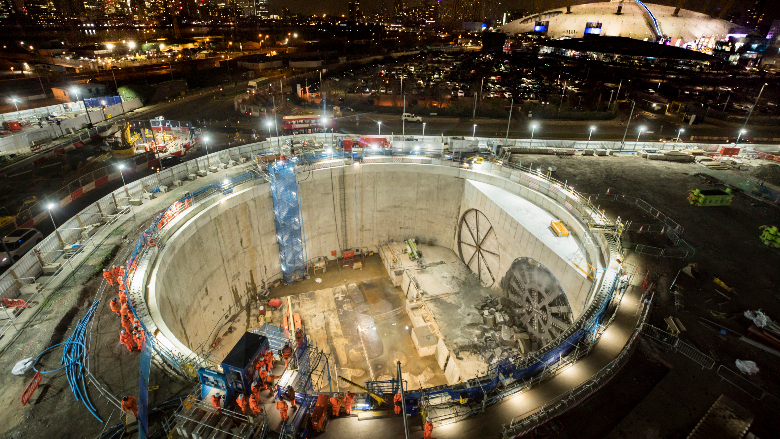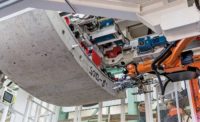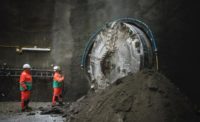Cross passages between both bores of London's 0.7-mile Silvertown tunnel are nearing completion in frozen ground, marking the end of excavations on the River Thames crossing. The $1.5-billion project's sole tunnel boring machine is in pieces, after completing the first drive, making a U-turn on a hydraulic cradle system with "air skates" and then boring the second tube. The approach allowed tunneling to wrap up 63 days ahead of schedule.
The U-turn strategy took less time than dismantling the machine and returning it to its launch shaft. But the challenge was to "rotate this monster—the biggest TBM ever used in the UK" and do it "quickly and safely," says Juan Martinez, president of Riverlinx CJV (RCJV), the design-build contractor for the project that adopted the U-turn approach for its bid for the work.
Turning the TBM was "unbelievable,” says Martinez. Planning to rotate the machine and start it boring northwards in 120 days, the job was done in "less than 90," he says.
"Obviously it was risky. But when you are innovating, you take risks...under control," Martinez says. "We were quite sure it was going to be a success and it was a success."
Two bored tubes with short cut-and-cover sections at both ends form the new crossing from Silvertown on the north bank to the Greenwich Peninsula, where it will join the access to the Blackwall tunnel. Opened 126 years ago, the twin bore Blackwall tunnel has, for years, been operating well above its design capacity, resulting in daily long queues.
Competing with a team led by Germany's Hochtief AG, in May 2019 Riverlinx SPV won the contract from Transport for London (TfL) to finance, design-build-maintain-operate the tunnel for 25 years.
Riverlinx SPV includes two financial institutions plus the project finance units of Spain's Ferrovial SA, Netherlands-based BAM PPP PGGM and South Korea's SK Engineering & Construction, now called SK Ecoplant. As part of the deal, Riverlinx SPV signed a roughly $1.2-billion design-build contract with Riverlinx CJV, consisting of BAM Nuttall, its affiliate Wayss & Freytag Ingenieurbau, Ferrovial Agroman and SK E&C. Ferrovial and BAM control 40% each with SK holding the balance.
Starting from Silvertown on the north riverbank, the 39-ft-dia earth pressure balance TBM drove to a large, 59-ft-deep open pit on the Greenwich Peninsula, arriving last February.
 The new tunnel is planned to ease traffic on the old Blackwall crossing. Map courtesy of TfL
The new tunnel is planned to ease traffic on the old Blackwall crossing. Map courtesy of TfL Because the 1,600-ton shield was inclined upwards by 4% in the shaft, it was tilted to the horizontal position with heavy lifting equipment, allowing the cradle system to be installed beneath. The cradle rested on 12 hydraulic pistons, each seated on an air skate riding over lubricated steel plates on the pit floor.
Supplied by Germany's Max Wild GmbH., the skates are of the type used for sliding heavy industrial and structural loads. Like a hovercraft, each skate floated on an air cushion contained by an inflatable skid.
To reduce fire risk, the team used inert nitrogen rather than air to lift the skates. "The big advantage of this...system is that you reduce the friction to [approximately] 1% of the weight," says Andre Stulz, field manager of the TBM supplier, Germany's Herrenknecht A.G. On each skid, "the machine is more or less floating on [a] nitrogen bubble." Herrenknecht expects the same procedure to be used soon on an undisclosed U.S. project.
 The nitrogen skates allowed the 1,600-ton TBM to be slid over the shaft's lubricated steel floor. Photos courtesy of Herrenknecht
The nitrogen skates allowed the 1,600-ton TBM to be slid over the shaft's lubricated steel floor. Photos courtesy of HerrenknechtOnce turned, the TBM completed the northbound drive in July and is now waiting to be recycled. Because of space constraints in Greenwich, spoil from the north drive was conveyed through the south tunnel back to Silvertown.
With tunneling complete, excavation work is now centered on the seven emergency passages, 39-ft to 65-ft long, between the main bores. Martinez had thought of injecting the wet sand and clay soil around the passages to keep out ground water. Instead, RCJV decided to freeze the ground in the four passages under the river. Dewatering them was ruled out because "the pressure would have been too much," says Chris Barrett, RCJV's freezing project manager.
Cross passage excavations are generally about 16.1 ft tall by 14.8 ft wide, finally reduced to about 9 ft by a sprayed concrete primary lining, a waterproof membrane and a cast-in-place finish. Before excavation started, each passage was enclosed in a roughly 43-ft-square shroud of frozen ground.
Under its roughly $8.5-million subcontract with RCJV, Germany-based Züblin Ground Engineering UK drilled 26 holes around each passage location from the south tunnel to the lining of the north bore.
It then circulated a calcium chloride solution at -35 degrees Celsius around the bore holes. It took 55 days to freeze the shorter passages, says Gustav Jahnert, Züblin's business development manager. Freezing started this July allowing excavation to kick off in September with a November completion target.
 Twenty-six freezing tubes enclose each passage location, an opening in the lining allows extraction of the frozen ground and a primary lining of sprayed concrete is applied. Photos by Peter Reina/ENR
Twenty-six freezing tubes enclose each passage location, an opening in the lining allows extraction of the frozen ground and a primary lining of sprayed concrete is applied. Photos by Peter Reina/ENRDespite some major headwinds, the project is going well, according to Helen Wright, TfL's project head. The pandemic hit as the project moved into construction, yet "the tunnel remains on track to open in [March] 2025, which is a huge achievement," she adds. "I’m particularly impressed that the tunneling was completed 63 days ahead of schedule."
As well as COVID-19, "wars, hyperinflation [and] scarcity of people is putting us in a difficult situation sometimes," says Martinez. Because of the project's private financing, the contractor has little scope to deviate from project goals. "You know [what] day you have to finish and if you don't finish that day the [penalties] are massive," he says.
To finance the tunnel deal, Riverlinx SPV secured loans from 15 institutions and provided an undisclosed amount of equity. The consortium will recoup its investment with inflation linked payments from TfL. "The first-year payment is expected to be $79 million minus any reductions for nonavailability," says Wright.
TfL also expects to spend $210 million on its own project investments, such as land acquisition and tolling infrastructure. But the final project bill will be paid by TfL tolls on 100,000 daily drivers who will use both the new and old tunnels.





Post a comment to this article
Report Abusive Comment